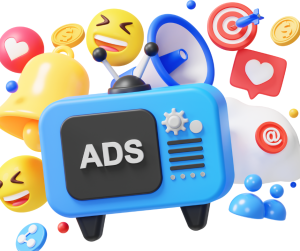In today’s fast-paced digital landscape, where attention is the ultimate commodity and consumer behavior constantly evolves, the realm of advertising has transformed into a sophisticated art form. Brands are no longer just creating advertisements; they are crafting experiences, guiding viewers on a journey from passive spectators to active participants in their brand story. Welcome to the era where decoding advertising strategies isn’t merely about reaching eyeballs but about turning those viewers into loyal customers.
As we navigate through the intricate web of digital marketing, it becomes clear that successful advertising strategies go beyond flashy campaigns and catchy slogans. They are meticulously designed blueprints that understand the nuances of consumer psychology, leverage cutting-edge technology, and tap into the pulse of societal trends. In this blog post, we delve deep into the dynamic world of advertising in the digital age, unraveling the strategies that hold the power to not just capture fleeting attention but to convert it into lasting customer relationships. Join us on this exploration as we decode the intricate mechanisms that drive modern advertising towards unparalleled success.
Understanding Consumer Behavior in the Digital Era
In order to create effective advertising strategies in the digital age, it is crucial to have a deep understanding of consumer behavior. With the rise of technology and the internet, consumers have become more empowered and informed than ever before. They have access to a wealth of information at their fingertips and can easily compare products, read reviews, and make informed purchasing decisions.
One key aspect of consumer behavior in the digital era is the importance of personalization. Consumers expect advertisements to be tailored to their individual needs and preferences. Generic, one-size-fits-all ads are no longer effective in capturing attention or driving conversions. Instead, brands need to leverage data and analytics to segment their target audience and deliver personalized messages that resonate with each individual.
Another important factor to consider is the influence of social media on consumer behavior. Platforms like Facebook, Instagram, and Twitter have become integral parts of people’s lives, shaping their opinions and purchase decisions. Brands need to establish a strong presence on social media and engage with their audience through compelling content that sparks conversations and builds relationships.
Furthermore, consumers today value authenticity and transparency. They are more likely to trust brands that are genuine and honest in their advertising efforts. This means avoiding misleading claims or exaggerated promises and instead focusing on delivering real value to customers.
Embracing Video Content for Engaging Ad Campaigns
In today’s digital landscape, video content has emerged as a powerful tool for engaging ad campaigns. With platforms like YouTube dominating online video consumption, brands have an opportunity to captivate audiences through visually compelling storytelling.
Video ads allow brands to convey emotions, tell stories, and create immersive experiences that resonate with viewers on a deeper level. They can evoke laughter, tug at heartstrings, or inspire action in ways that traditional static ads cannot. By leveraging the power of sight, sound, and motion, brands can create memorable experiences that leave a lasting impression on consumers.
Moreover, video content is highly shareable and has the potential to go viral. When viewers find a video ad interesting or entertaining, they are more likely to share it with their friends and followers on social media. This not only increases brand visibility but also generates valuable word-of-mouth marketing.
However, it is important for brands to strike a balance between entertainment and brand messaging in video ads. While creativity and storytelling are essential, the core message should not be overshadowed. The ad should clearly communicate the brand’s value proposition and call-to-action to drive conversions.
Navigating the Landscape of Influencer Marketing
Influencer marketing has become a prominent strategy in the digital advertising landscape. By partnering with influencers who have a large following and influence over their audience, brands can tap into their credibility and reach to promote their products or services.
One of the key advantages of influencer marketing is its ability to target niche audiences. Influencers often have a specific niche or interest area that aligns with certain brands or products. By collaborating with influencers who cater to these niche audiences, brands can ensure that their message reaches the right people who are more likely to be interested in what they have to offer.
Additionally, influencer marketing allows for authentic storytelling. Influencers have built trust with their audience through consistent content creation and engagement. When they endorse a product or service, it feels like a genuine recommendation rather than an advertisement. This authenticity resonates with consumers and can significantly impact their purchasing decisions.
However, it is important for brands to carefully select influencers whose values align with theirs. The influencer’s reputation reflects on the brand they promote, so it is crucial to choose influencers who have a positive image and are aligned with the brand’s values and target audience.
Optimizing Ad Placement for Maximum Impact
While creating compelling ad content is important, it is equally crucial to optimize ad placement for maximum impact. In the digital age, consumers are constantly bombarded with advertisements across various platforms and devices. To cut through the noise and capture attention, brands need to strategically place their ads where their target audience is most likely to see them.
One effective strategy is programmatic advertising, which uses algorithms and data analysis to automate ad buying and placement. This allows brands to reach their target audience at the right time and in the right context. By leveraging data on consumer behavior, interests, and demographics, brands can deliver personalized ads that are more likely to resonate with viewers.
Another important aspect of ad placement optimization is mobile advertising. With the widespread use of smartphones, mobile devices have become a primary channel for consuming digital content. Brands need to ensure that their ads are optimized for mobile viewing and seamlessly integrated into mobile apps or websites.
Furthermore, native advertising has gained popularity as an effective way to blend ads seamlessly into the user experience. Native ads match the form and function of the platform on which they appear, making them less intrusive and more engaging for users.
Measuring Success: Metrics and KPIs in Digital Advertising
In order to evaluate the effectiveness of advertising strategies in the digital age, it is essential to measure success using relevant metrics and key performance indicators (KPIs). These metrics provide valuable insights into how well a campaign is performing and help identify areas for improvement.
One common metric used in digital advertising is click-through rate (CTR), which measures the percentage of people who click on an ad after seeing it. A high CTR indicates that the ad is capturing attention and generating interest among viewers.
Conversion rate is another important metric that measures the percentage of people who take a desired action, such as making a purchase or signing up for a newsletter, after clicking on an ad. This metric directly reflects the effectiveness of an ad in driving conversions and generating revenue.
Other metrics to consider include cost per acquisition (CPA), return on ad spend (ROAS), and customer lifetime value (CLV). These metrics provide insights into the cost-effectiveness of advertising campaigns and the long-term value generated from acquiring new customers.
Conclusion: Transforming Viewers into Loyal Customers
In conclusion, advertising strategies in the digital age have evolved to focus on transforming viewers into loyal customers. By understanding consumer behavior, embracing video content, leveraging influencer marketing, optimizing ad placement, and measuring success through relevant metrics, brands can create impactful campaigns that resonate with their target audience and drive conversions.
In this fast-paced digital landscape, where attention is scarce and competition is fierce, it is crucial for brands to continuously adapt their advertising strategies to stay ahead. By staying informed about emerging trends and technologies, brands can unlock new opportunities for growth and build lasting customer relationships in the digital age.






